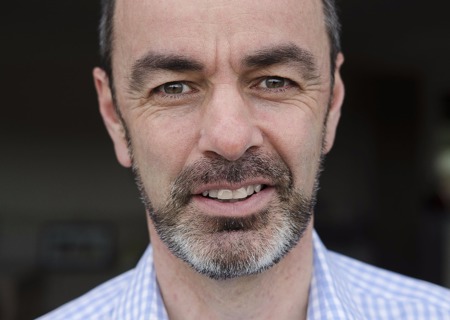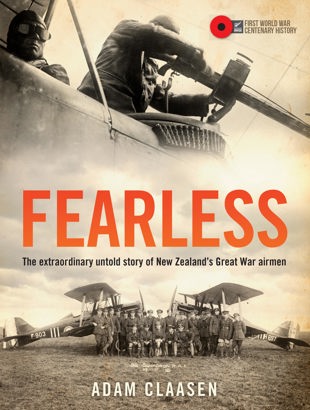1. Is this a book you’ve long been wanting to write?
I actually had plans for something completely different until I was made aware that the people at the Centenary History Programme were wanting a volume on New Zealand airmen in the Great War. When I heard this I got to pondering the possibilities. I soon realised that although a lot had been written about the New Zealand soldiers at Gallipoli and on the Western Front, virtually nothing had appeared in print on the airmen in the First World War. As I got into my research and writing I was surprised by the fact that New Zealanders could be found across the entire conflict, from Britain to Mesopotamia, and were involved in such a vast variety of roles. New Zealanders carried out reconnaissance work, bombing sorties and engaged in aerial combat to name but a few of their endeavours. As the book unfolded I realised how fortunate I was to be telling their stories.
2. Proud of it?
Very much. I’m very proud of the fact that it brings to light so many young men who really deserve a more prominent place in New Zealand’s First World War history.
3. Why ‘Fearless’?
It’s less about the absence of fear and more about the attitude of knowing the perils inherent in early military aviation and still doing it. Training alone accounted for between a quarter to a third of all losses in the Royal Flying Corps — that’s even before you get to a frontline squadron. And those airmen that did make it to the Western Front and elsewhere found that their chances of surviving were slim. A lot of the New Zealanders lost their lives within the first six weeks of being posted to an operational squadron. The life expectancy of an airman was incredibly short and their bravery astonishing, hence: ‘Fearless’.
4. What did your research involve?
Initially getting some good advice and direction from some ‘old hands’ in the field and then diving into the research and writing. I had a handful of very good reference resources (publications on air losses, etc.) but almost nothing on the story of the New Zealand airmen. Only one New Zealander had published his memoirs. Thus, the greater part of Fearless is built around exploiting what historians call primary materials: letters, diaries, logbooks and official documents that survive the war. Nearly all of the personal materials were from private collections and archival repositories in New Zealand. Families shared the prized mementos of their flying forebears, and archival staff at the Air Force Museum of New Zealand, the Alexander Turnbull Library and Archives New Zealand made a vast array of materials available for examination. These documents paint a vivid picture of the daily thrills and dangers of New Zealand aviators in the Great War. In Britain, the flying service files are voluminous, and I spent a good deal of time scouring them for such things as combat reports and squadron record books. A lot of the stunning photographs which grace the pages of the book are from the Imperial War Museum, London, the Air Force Museum of New Zealand and generous private collectors, including Sir Peter Jackson.
5. The book is full of the most remarkable characters. Who is one of your favourites, and why?
Probably one of the most powerful stories for me was that of William Coates. When I started the book he was the first person I learnt about. I visited the old family homestead in the Kaipara, Northland, and got to see where he grew up with his older brother, Gordon, who rose to considerable fame on the Western Front in the ground war and later became Prime Minister of New Zealand. Seeing William’s bedroom and sitting in the living room looking over his letters home really made me think about where these young men came from and who and what they were leaving behind when they embarked for war. William left as an infantryman with the New Zealand Expeditionary Force, but like so many he wanted to advance to the air corps. He wrote numerous letters to his mother, Eleanor, about his hopes for the future and starting a family. He was one of the select few to succeed in gaining a transfer to the RFC. He completed his training and was posted to the front full of excitement having fulfilled his dreams of flight. In France he discovered that Gordon was based nearby. William fetched him in the squadron’s tender and they had dinner and talked of home late into the night. The next morning William proudly showed Gordon his ‘shot-up’ machine before delivering him back to his camp of tents. William was killed in action soon after. The story of his death and Gordon’s desperate search for more information are heart-rending. Eleanor never fully recovered from the loss of her son.
6. What’s one new thing you learnt while working on this book?
That squadron commanders had an unenviable job. New Zealand produced a number of excellent commanding officers, including Alan Scott and Rainsford Balcombe-Brown. Scott, who led a fighter squadron in France, is an intriguing character who, thanks to a flying accident badly damaging his legs, had to be assisted in and out of his aircraft and walked with the aid of two canes. It was not unknown for him to undertake an early-morning mission in his pyjamas. Alongside his eccentricities he was a thoughtful and caring commander. A number of the men who were posted to his squadron were totally unsuited to flying the light and skittish single fighters of 60 Squadron and he had the delicate job of ‘moving them on’. His correspondence to his superiors in this regard walks the fine line of asking for their transfer and yet not undercutting pilot’s reputation.
Balcombe-Brown was a considerable scholar who knew a number of languages and had studied at Oxford before he went on to command one of the RFC’s most prestigious squadrons. Among the records held at the National Archives in London are a remarkable set of letters he wrote in his capacity as CO to the parents and wives of young men who had failed to returned from missions. Balcombe-Brown navigates treacherous waters as he tries to not raise unfulfillable expectations and yet leave the door open for the fact the individual in question might have been captured rather than killed. That this own brother had been killed earlier in the war doubtless tempered his letters.
7. If you could race back in time to, say, 1916, can you imagine wanting to take off in one of those tiny, fragile planes?
I’ve been up in a few small aircraft, but they have all been modern single-engine machines. Mechanical failures and air accidents today are very rare events, not so in 1916! The idea of climbing into a timber, wire and fabric machine in 1916 does not fill me with great confidence. As the war progressed, aircraft improved markedly, but any operational sortie was full of uncertainty; anti-aircraft fire or aerial attack were constant dangers. Since the British Empire airmen flew without parachutes the options available in a fatally damaged machine were not good, and terrible in a machine that was on fire. Of course, if it were possible to hitch a ride in a replica machine today, it would be a completely different matter. For example, the Vintage Aviator Ltd in Masterton manufactures reproduction First World War machines within the demands of modern flying regulations and technology. And flying over the Wairarapa would be far less dangerous than over the Somme in 1916.
8. Was the project exhilarating or exhausting?
Three-quarters exhilarating one-quarter exhausting. The adventures of the airmen where exhilarating and the research was rewarding, but demands of getting the book finished within the deadline for publication this year was stressful, frustrating and consumed not just weekdays but also weekends and evenings. Hopefully readers will think the effort was worth it.
9. What’s one thing you hope people will take away from reading Fearless?
An appreciation of the service and sacrifice of the New Zealand men and women who served in military aviation in the Great War.
10. What are you reading at the moment, for work and for pleasure?
I’ve just finished The Girl With All the Gifts by M. R. Carey, which is a different slant on the zombie genre; lovely turns of phrase in places and some nice metaphors used throughout. Well worth reading. I’m also dipping into Garry Kasparov, How Life Imitates Chess. I’m generally not a big fan of motivational books, but someone lent me this and I really love playing chess and admire the author, so we’ll see how it goes. On the bedside cabinet I have Why I Write, a collection of George Orwell’s essays. Orwell is always good value, such a great stylist and timeless political commentator.


